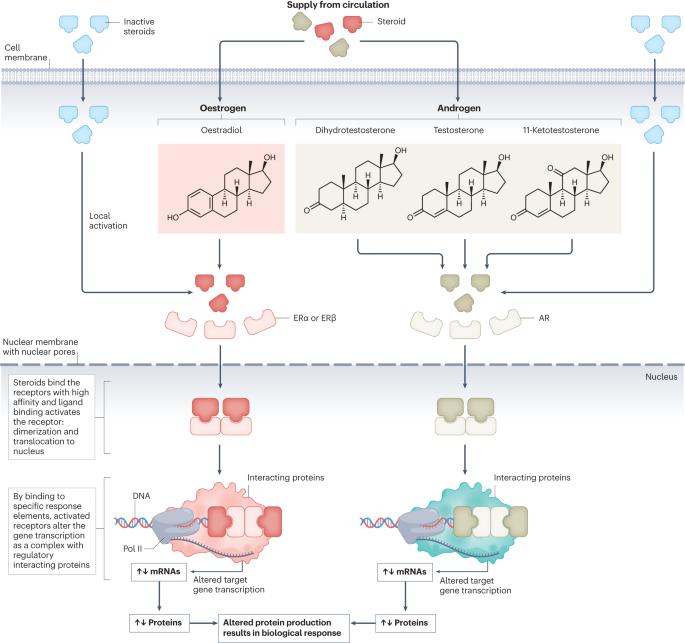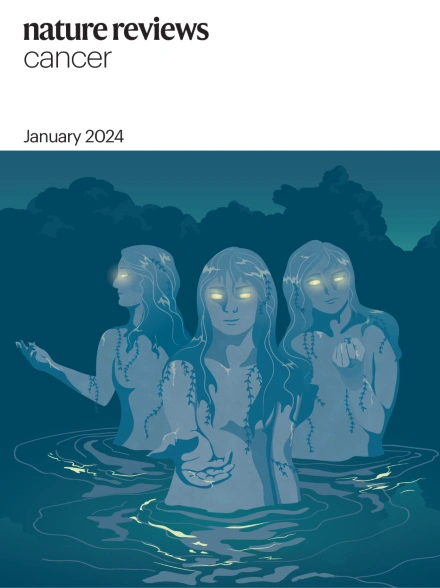以性类固醇生物合成为靶点治疗乳腺癌和前列腺癌
IF 72.5
1区 医学
Q1 ONCOLOGY
引用次数: 0
摘要
性类固醇是乳腺癌和前列腺癌生长的主要促进因素。这篇由 Poutanen 等人撰写的综述介绍了针对这些癌症类型的治疗方法的发展情况,这些治疗方法通过抑制类固醇的生物合成来限制性类固醇与受体结合的可用性,是对传统性类固醇拮抗剂作用机制的补充。性类固醇,如雄激素和雌激素,是分别主要调节男性和女性生殖器官生理机能和维持生殖能力的激素。到了晚年,这些性类固醇会成为乳腺癌和前列腺癌等生殖组织癌症生长的主要促进因素,其中乳腺癌是女性最常见的癌症,而前列腺癌则是男性第二常见的癌症。雌激素和雄激素通过作为类固醇激活转录因子的特定受体蛋白发挥作用。因此,目前所有治疗乳腺癌和前列腺癌的内分泌疗法都直接或间接地针对类固醇受体的相互作用。这些疗法包括抑制性腺中由促性腺激素调节的类固醇生物合成的化合物、雌激素和雄激素受体的拮抗剂和降解剂,以及雌激素和雄激素生物合成酶的抑制剂。这类酶抑制剂可以通过阻断肿瘤中雌激素和雄激素及其前体在性腺和肾上腺中的生成、阻碍肿瘤中血液运输前体的活化和/或抑制肿瘤中任何局部类固醇的新生物合成,从而降低肿瘤中强效雌激素和雄激素及其前体的浓度。一些特征明确的雌激素和雄激素经典生物合成途径酶抑制剂已被用于治疗乳腺癌和前列腺癌,新型化合物也在开发中。然而,并非所有参与性类固醇生物合成的酶都已被发现。此外,最近还发现了具有生物活性的新型性类固醇,如 11 氧代雄激素。因此,迄今尚未发现的抑制性类固醇生物合成的靶点和新机制有望为更有效地治疗依赖性类固醇的乳腺癌和前列腺癌提供进一步的工具。本文章由计算机程序翻译,如有差异,请以英文原文为准。


Targeting sex steroid biosynthesis for breast and prostate cancer therapy
Sex steroids are major promoters of the growth of breast and prostate cancers. This Review by Poutanen et al. describes the development of treatments for these cancer types that act to restrict sex steroid availability for receptor binding by inhibiting steroid biosynthesis, being a complementary mechanism of action to the more traditional sex steroid antagonists. Sex steroids, such as androgens and oestrogens, are hormones that primarily regulate the physiology of reproductive organs and maintain reproductive capacity in both men and women, respectively. Later in life, these sex steroids can become major promoters of the growth of cancer in the reproductive tissues, such as the breast and prostate, with breast cancer being the most common cancer in women and prostate cancer being the second most common cancer in men. Oestrogens and androgens act via specific receptor proteins that act as steroid-activated transcription factors. Accordingly, all current endocrine therapies for breast and prostate cancer target steroid–receptor interactions either directly or indirectly. These therapies encompass compounds that inhibit gonadotropin-regulated steroid biosynthesis in the gonads, antagonists and degraders of oestrogen and androgen receptors, and inhibitors of enzymes of oestrogen and androgen biosynthesis. Such enzyme inhibitors can reduce the concentration of potent oestrogens and androgens and their precursors in the tumours by blocking their gonadal and adrenal production, by hindering the activation of the blood-transported precursors within the tumours and/or by inhibiting any local de novo steroid biosynthesis in the tumours. Some well-characterized inhibitors of enzymes of the classical biosynthesis routes of oestrogens and androgens are used in the treatment of breast and prostate cancer, and novel compounds are in development. However, it is likely that not all enzymes involved in sex steroid biosynthesis have been discovered. Furthermore, novel biologically active sex steroids, such as 11-oxygenated androgens, have been more recently identified. Accordingly, so-far-unidentified targets and novel mechanisms for inhibiting sex steroid biosynthesis are expected to provide further tools for more efficient therapies for sex steroid-dependent breast and prostate cancer.
求助全文
通过发布文献求助,成功后即可免费获取论文全文。
去求助
来源期刊

Nature Reviews Cancer
医学-肿瘤学
CiteScore
111.90
自引率
0.40%
发文量
97
审稿时长
6-12 weeks
期刊介绍:
Nature Reviews Cancer, a part of the Nature Reviews portfolio of journals, aims to be the premier source of reviews and commentaries for the scientific communities it serves. The correct abbreviation for abstracting and indexing purposes is Nat. Rev. Cancer. The international standard serial numbers (ISSN) for Nature Reviews Cancer are 1474-175X (print) and 1474-1768 (online). Unlike other journals, Nature Reviews Cancer does not have an external editorial board. Instead, all editorial decisions are made by a team of full-time professional editors who are PhD-level scientists. The journal publishes Research Highlights, Comments, Reviews, and Perspectives relevant to cancer researchers, ensuring that the articles reach the widest possible audience due to their broad scope.
 求助内容:
求助内容: 应助结果提醒方式:
应助结果提醒方式:


